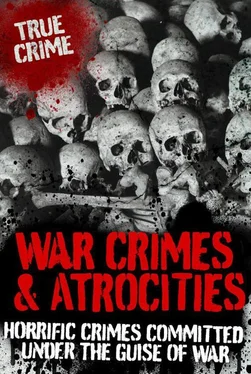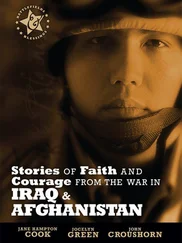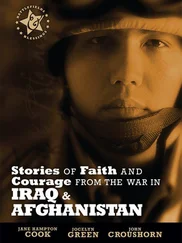Every single caravan had a continuous battle not only against the soldiers, but the gendarmes, convicts who had been released from jail, and the local Turkish tribes. They had no strong, virile men to protect them, as the Turks had already made sure that they were out of the way, and so the weak were left to fend for themselves. Any of the Armenians who did manage to escape usually didn’t get far before they were set upon, helpless without any form of weapon to defend themselves. Those that were not killed by the bayonet were ravaged by hunger and thirst, adding to their torment. The hot sun of the desert shrivelled the skin on their scantily clad bodies, and after several days of travelling, the once healthy Armenians were nothing more than pathetic skeletons.
The end result was an almost total extermination of the Armenian population, with only about 150 women and children reaching their final destination. They arrived naked, having had their clothes ripped from their bodies as they travelled. Already in an emaciated state, most didn’t survive the squalid camps that had been set up in Syria and Mesopotamia (Iraq), as the spread of disease was rampant.
Although the majority of the massacres took place in 1915, the genocide continued until the end of World War I in 1918.
THE AFTERMATH
Turkey’s final defeat at the end of World War I, and the subsequent collapse of the Ottoman Empire, gave the surviving Armenians a chance to try and rebuild their nation. In 1918 an independent Republic of Armenia was declared, giving them back some of the pride that had been stripped by the evil CUP. For several decades the rest of the world was unaware of the horrors inflicted on the Armenian people, and for a long time was overshadowed by the Nazi’s genocide of the Jewish race in World War II. Turkish governments have maintained a constant silence on the subject, which has been sustained by lying, deliberately forged propaganda and bribes.
The day that it all began was 24 April, and Armenians living around the world commemorate the genocide at the site of memorials raised by the survivors, despite the fact that several governments do not officially recognize the genocide ever took place.
1919

The Amritsar Massacre, also known as the Jallianwala Bagh Massacre, took place in the city of Amritsar in Punjab, in the northern part of India. In the years following the end of World War I, India was still reeling from the effects of British rule. Indian soldiers who had returned as heroes from the front line found themselves once again being treated as natives. The actual issue that caused the sinister, if not extraordinary, event in the Jallianwala Bagh garden, was the government’s passing of the Rowlatt Acts in March 1919. The Acts were introduced to try and curb the growing violence that was breaking out in various parts of India, in particular the Punjab. They allowed the government of India to arrest known agitators without a formal trial, giving judges the right to sentence without a jury. The Acts came just after the end of World War I, in a time of peace, when many Indians were hopeful of some form of self-government.
It soon became obvious that the British government had no such intention of relaxing its hold on India. When the Acts were actually passed, the leader of the Indian National Congress, Bal Tilak, was away in London, leaving the way open for Mahatma Gandhi to emerge as the true leader of the Congress. Gandhi urged all Indians to take sacred vows to disobey the Rowlatt Acts and launched a nationwide movement for the repeal of such repressive measures. His appeal received the strongest response in the Punjab, where two nationalist leaders Kichloo and Satyapal addressed mass protest rallies. Gandhi was arrested when he was on his way to Punjab to attend one of their rallies, and was taken back to Bombay on the orders of Punjab’s governor, Sir Michael O’Dwyer.
On 10 April, 1919, Kichloo and Satyapal were both arrested in Amritsar and deported from the district by Deputy Commissioner Miles Irving. Their followers were outraged and proceeded to march to Irving’s residence, demanding the release of the two men. No sooner had they arrived than they were fired on by British soldiers. With several of their men either killed or wounded, the now incensed mob rioted through the old city of Amritsar. They set fire to houses and property associated with the British rule, and four European men were brutally murdered.
General Dyer was ordered to take Gurkhas and Balochi troops to try and restore order and, as a result, around 20 Indians were killed before the end of the day.
DEPLORABLE ACT
The protection of women and children by the white population in India had been a major priority since the Indian Rebellion of 1857. They were considered a defenceless and vulnerable part of society, open to the despoliation of the natives. So when an English woman, Miss Marcella Sherwood, a Church of England missionary, was molested on a street in the city of Amritsar, the repercussions were enormous.
Miss Sherwood had been a resident in Amritsar for over 15 years and, although she was not involved in the riots in any way, she was unable to escape the wrath of the crowd. As she was cycling down one of the narrow streets, she was set upon by an enraged crowd of Indians. They knocked her off her bicycle and hit her around the head with sticks while she lay on the ground. Miss Sherwood, despite her injuries, managed to get onto her feet and as she tried to run away from the crowd, she was once again brought down. On her second atempt, Miss Sherwood managed to run to a house to ask for help, but as she knocked on the door, the occupant simply slammed it in her face. Again the crowd set on her and left her criticially injured on the side of the road. After the crowd had dispersed, a rescuer came to her aid and prompt medical attention saved her life.
THE REVOLUTION TAKES HOLD
Although the city of Amritsar was quiet for the next few days, the rumbles of revolution could be heard in other parts of the Punjab. Government buildings were burnt, railway lines and communication cables were destroyed, and a further three European men were murdered in a period of three days. On the third day following the attack on Miss Sherwood, 13 April, the government decided to place Punjab under martial law. The troops at the disposal of General Dyer included 475 British and 710 Indian soldiers.
The 13 April also marked the Baisakhi festival, and a large number of people, mostly Sikhs, had poured into the city of Amritsar from the surrounding villages. In the morning, Dyer’s soldiers had gone through the streets of the city to announce that any group meetings would be dispersed by force, using arms if it was necessary. At 4.30 p.m. a crowd of around 15,000 to 20,000 Indians had gathered for a meeting in the Jallianvala Bagh (or garden), a large unused piece of land in the heart of Amritsar that was surrounded by crude walls and just one, single exit.
As soon as Dyer heard of the defiance to his orders, he headed for Jallianvala Bagh with 50 riflemen (mostly Indian and Gurkhas) and two armoured cars. Dyer positioned his men by the narrow entrance into the bagh, ensuring that there was no possibility of anyone making a quick escape. The ground surrounding the entrance was slightly higher than the rest of the bagh, which gave the troops an excellent vantage point. It was here that they waited for the order from Dyer.
Dyer gave the command, without giving any warning to the crowd inside the bagh, for his troops to open fire where the mob was most concentrated. The firing continued indiscriminately for over 20 minutes, and they spent over 50 rounds of ammunition. People attempted to flee as best they could, but many were trampled in the ensuing stampede. Some mothers, still clutching their children, jumped into a well in an attempt to escape the constant rain of bullets.
Читать дальше













